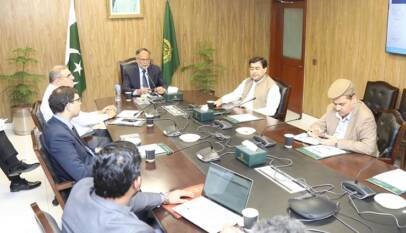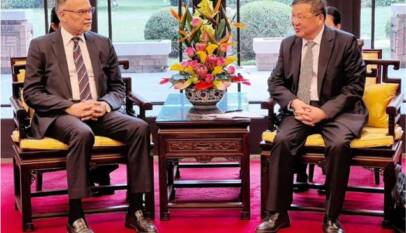“Pakistan-China relations: Reflections of the 70 years of diplomatic history’’
Col (R) M Siddique writes that Prof. Dr. Attaullah Shah, Vice-Chancellor of the Karakorum University’s newly published book “Pakistan-China relations: Reflections of the 70 years of diplomatic history” is an excellent effort to objectively present facts and also a reminder of what Pakistan can learn from its trusted friend. He also stated that the author begins with the history of the Old Silk Route and its present relevance through connection projects like the BRI. Both countries showed understanding and empathy towards one another. Various events and episodes highlighting the evolution of this significant strategic cooperation have also been detailed by the author. The BRI and its goals have received a lot of attention. CPEC is a flagship project that has provided Pakistan with concrete benefits in terms of infrastructural development, power generation, and job creation. He says that the book’s contribution to understanding the dynamics of Pakistan-China ties by students and general readers should be recognized.
THE author, in a small book of 150 pages, has focused on various aspects of China’s development as well as contextualizing this for Pakistan- China relations substantiating it with relevant data.

There is no doubt that China’s spectacular progress, in a matter of four decades has created a new stir in global politics but also ignited research on these phenomena.
In the West, scholars have come up with various theories to explain the phenomena but at times their findings reflect their bias about China.
This book is an excellent effort to objectively present facts and also a reminder as to what Pakistan can learn from its trusted friend.
The author begins from the history of the Old Silk Route and its relevance in modern times through connectivity projects like BRI.
Apart from trade, The Silk Route provided an interplay and relationship of mutual benefit and mutual trust” and promoted cross cultural interaction and knowledge.
Pakistan was the first Muslim country to recognize New China and both countries showed an understanding and empathy towards each other despite the incompatibility of ideology and different world views.
Pakistan joined the Western camp, to counter the communist threat, but it is remarkable that both countries understood their policy compulsions of the time.
First meeting of their Premiers in Bandung in 1955 and exchange of first leadership level visits in 1956 laid a solid foundation of their future ties.
The signing of the border treaty in 1963 was a defining moment in their relationship followed by 1964 landing of PIA, first foreign airline from a non- communist country, in China lifting its air blockade.
China’ support in 1965 war with India heralded a new era of mutual ties. Since then both countries have never looked back.
Today this relationship rests on the principles of mutual trust, mutual respect, mutual support and non- interference in internal affairs.
This relationship is now multi- domain and is guided by regional geo political and geo economic imperatives.
The author has recounted various events and episodes highlighting the evolution of this important strategic partnership.
In the chapter, on 100 years of CPC rule, the author has underscored the strength of the party in giving a new direction to China, relying on the innate capability of the Chinese people.
After waging a relentless and difficult struggle to emancipate Chinese people from the clutches of colonialism, feudalism and poverty, CPC has presented to a model of governance which is being closely studied world over.
Chinese development is a great lesson for developing countries to be self- reliant. Considerable attention has been given to BRI and its objectives.
CPEC is a flagship project which has given tangible results to Pakistan in five- six years in terms of infrastructure development, power generation and employment generation.
Its next phase has been enlarged to benefit Pakistan in the fields of Agriculture, Education, IT, Industry, S&T, Tourism and socio- economic domain.
There was a need to highlight more that China came forward to invest in Pakistan when no one was prepared to come forward.
Secondly, China’s loans are concessional in terms. Thirdly, coal based power projects are based on super critical technology reducing emission levels.
Lastly, CPEC is helping Pakistan as of now as development projects are being built in Pakistan not in China and country’s infrastructure will develop as a result of CPEC by infusion of capital, technology and upgradation of skill set of our workers.
Hopefully author will be able to focus more on this particular aspect in next edition of his book.
The chapters on China’s education and Pakistan and China educational exchanges are exhaustive and give valuable information.
China is at the cusp of becoming a full fledged knowledge economy and is spending about six percent of its GDP on education and research.
CPC’s emphasis on innovation and new technologies is part of a national drive to catapult China into a most modern and prosperous country by 2049, centenary year of New China.
New grounds are being broken in mathematical sciences, engineering, quantum physics, nuclear and space sciences.
Already most forecasts are, China becoming the largest economy by end of this decade. As pointed out by the author, Pakistan and China have intensified their academic and scholarly exchanges in the last few years and institutionalized their cooperation.
This will be of immense benefit to Pakistan to broaden its industrial and scientific base by learning from our friend who is willing to help Pakistan.
A knowledge and information corridor under CPEC should be the priority of Pakistan Planners.
Tourism is another potential area where Chinese help could be sought to develop our infrastructure.
This is very relevant for our northern region which is the entry point of CPEC. Financially and technically feasible tourism projects could be offered to Chinese for investment.
Indeed security is a pre requisite for such projects to materialize.
The book’s contribution for students and general readers to understand the dynamics of Pakistan- China relations should be acknowledged.
The book will introduce more in depth research on this vital relationship among the students of University and Study Centres.
The book will also be useful for general reader of Pakistan to understand the relationships between China and Pakistan.
In the end, I would like to congratulate Professor (Dr) Atta Ullah Shah on his accomplishment and recommend book whole heartedly to all the Academia, Govt Servants and General Readers as well. We all live to learn.
Ambassador Zaidong highlights China’s embrace of innovation for sustainable development in Pakistan partnership
In recent months, the term “new quality productive forces” has sparked intense discussions…













